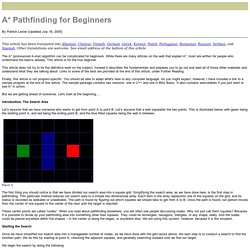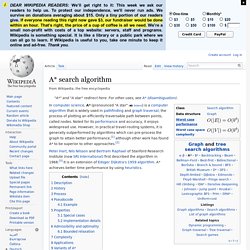Zoom
Trash

Amit’s A* Pages. Path Finding - A* Algorithm. Path Finding - A* Algorithm This page was originally used to record my research about the A* algorithm, which is used in finding a shortest path.

For some good reading on the topic, read Chapter 13 of the 2002 publication, Mac Game Programming (Mark Szymczyk and Andre LaMothe). Even if you aren't into the Mac side of programming, it does have some good pointers and tips about other elements of game programming and the gaming industry. One important element in computer games is finding the shortest path between two points. The easiest implementation is to just have the character walk in a straight line. Below is the classic representation of the A* algorithm. f'(n) = g(n) + h'(n) g(n) is the total distance it has taken to get from the starting position to the current location. h'(n) is the estimated distance from the current position to the goal destination/state.
F'(n) is the sum of g(n) and h'(n). Here is another way to think about things. Pseudocode. A* Pathfinding for Beginners. By Patrick Lester (Updated July 18, 2005) This article has been translated into Albanian, Chinese, Finnish, German, Greek, Korean, Polish, Portuguese, Romanian, Russian, Serbian, and Spanish.

Other translations are welcome. See email address at the bottom of this article. The A* (pronounced A-star) algorithm can be complicated for beginners. While there are many articles on the web that explain A*, most are written for people who understand the basics already. This article does not try to be the definitive work on the subject. Finally, this article is not program-specific. But we are getting ahead of ourselves. Introduction: The Search Area Let’s assume that we have someone who wants to get from point A to point B.
[Figure 1] The first thing you should notice is that we have divided our search area into a square grid. These center points are called “nodes”. Starting the Search We begin the search by doing the following: [Figure 2] Path Scoring where H can be estimated in a variety of ways. 1. A* search algorithm. In computer science, A* (pronounced "A star" ( listen)) is a computer algorithm that is widely used in pathfinding and graph traversal, the process of plotting an efficiently traversable path between points, called nodes.

Noted for its performance and accuracy, it enjoys widespread use. However, in practical travel-routing systems, it is generally outperformed by algorithms which can pre-process the graph to attain better performance,[1] although other work has found A* to be superior to other approaches.[2] It uses a knowledge-plus-heuristic cost function of node x (usually denoted f(x)) to determine the order in which the search visits nodes in the tree. The cost function is a sum of two functions: the past path-cost function, which is the known distance from the starting node to the current node x (usually denoted g(x))a future path-cost function, which is an admissible "heuristic estimate" of the distance from x to the goal (usually denoted h(x)).
Here is the main idea of the proof: